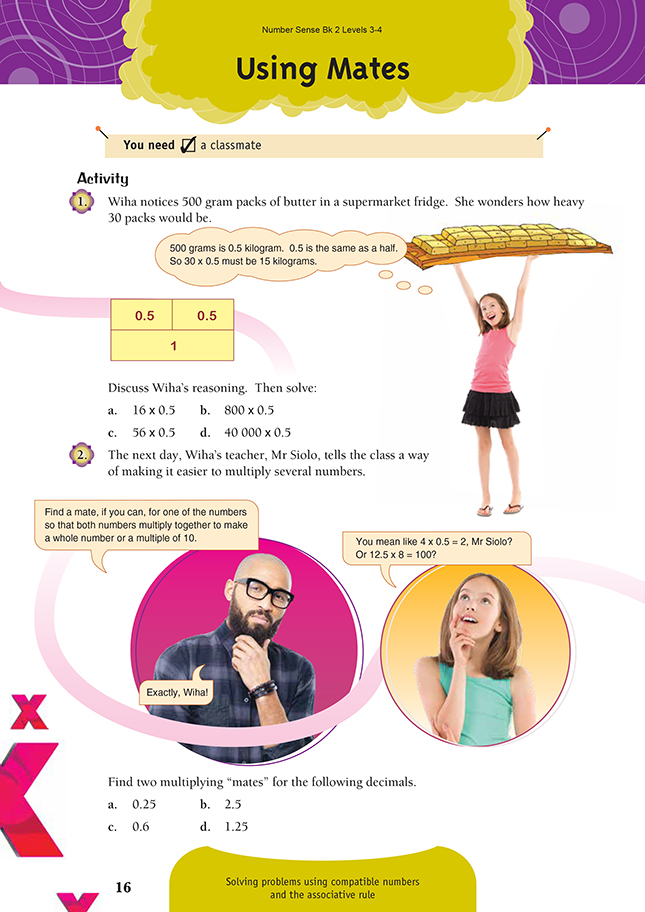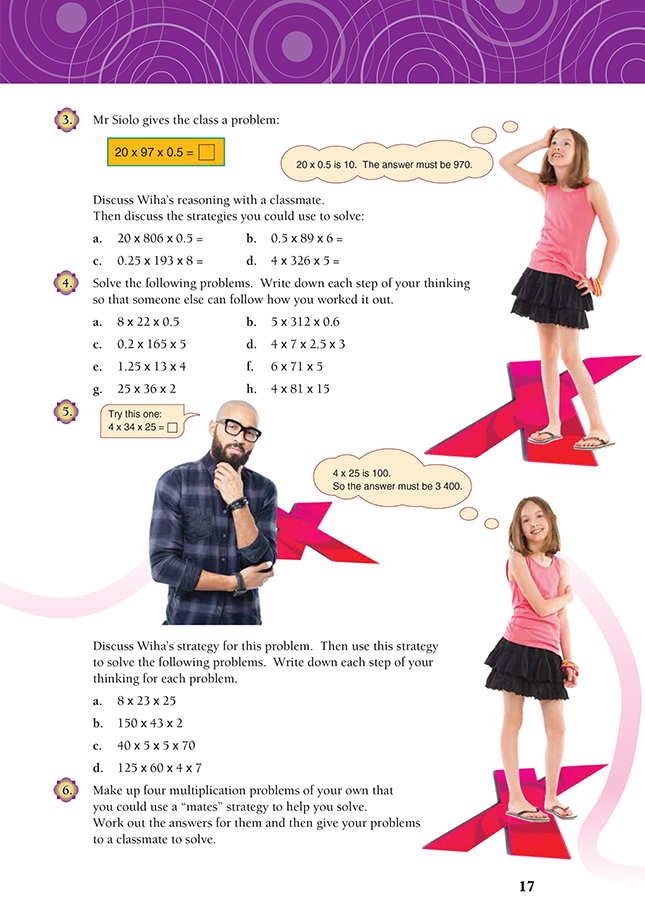This is a level 5 number activity from the Figure It Out series. It relates to Stage 8 of the Number Framework.
A PDF of the student activity is included.
Click on the image to enlarge it. Click again to close. Download PDF (522 KB)
solve problems using the associative rule
Number Framework Links
This activity, which involves multiplication, is suitable for students using advanced multiplicative strategies (stage 7) or higher.
FIO, Levels 3-4, Number Sense and Algebraic Thinking, Book Two, Using Mates, pages 16-17
A classmate
This activity focuses on solving problems with fractions and decimals, using compatible numbers and the associative rule.
When you are teaching this activity (and Compatible Multiples, page 21), it’s very important to challenge the idea that multiplication always involves increasing the size of something (and division always involves reducing the size of something). Because this is always the case when working with whole numbers, some students don’t realise that it isn’t true for all numbers. The key idea is that multiplying any (positive) number by a number greater than 0 and less than 1 decreases it. (For example, 5 x 0.6 = 3; 3 is less than the 5 we started with.) See the Numeracy Project resource list
below.
This activity does not involve negative numbers, but similar issues come up there: doubling a negative number gives a number that is less, not more, than the starting number.
In question 1, Wiha realises that, instead of multiplying by 0.5, she can use a doubling and halving strategy to solve the problems quickly and obtain the weight of the packets in kilograms. Some students will find this confusing if they focus on the fact that multiplication usually makes things bigger. In this case, the answer is half of the multiplier. Discuss why this occurs. Point out that “multiplied by” can be thought of as “of”, for example, 6 x 0.5 is 6 lots of 0.5.
Question 2 challenges the students to find compatible numbers to make multiplying decimals easier. The students need to be able to justify their choice of combinations, for example:
0.5: 0.5 x 2 = 1 or 0.5 x 10 = 5
2.5: 2.5 x 2 = 5 or 2.5 x 4 = 10.
In question 3, the students apply their understanding of compatible decimal numbers and derived multiplication facts to solve problems that involve three numbers and explain their strategies. In doing this, they need to use the principles of commutativity, distributivity, and associativity:
• Commutativity is the principle of reversability that allows us to use whatever order suits us when adding or multiplying, for example, 8 x 0.5 = 0.5 x 8
• Distributivity is the principle that allows us to group numbers or split them for purposes of multiplication, for example, 12 x 14 = 12 x (10 + 4)
= (12 x 10) + (12 x 4)
= 120 + 48
= 168
This is the principle underlying part–whole thinking.
• Associativity is the principle that allows us to add or multiply more than two numbers by grouping them in whatever pairs suit us or the problem, for example, 2 + 3 + 4 = (2 + 3) + 4 or 2 + (3 + 4) or (2 + 4) + 3. In each case in this example, two of the numbers are added together and the result is added to the third number. (Addition and multiplication are binary operations: they can only be done with two numbers, not three or more. A computer adding or multiplying a million numbers would still pair them up at each stage to do so.)
With questions 3–6, you could insist that the students use brackets each time they work with the associative principle. This will help them to understand what they are doing and also makes it clear to an onlooker how they are grouping pairs of numbers.
For example:
“20 x 806 x 0.5 = (20 x 0.5) x 806 = 10 x 806
= 8 060
0.5 is a half, so 20 can be halved to 10, which makes the multiplication of 806 easy.”
“0.25 x 193 x 8 = (0.25 x 8) x 193
= 2 x 193
= 2 x 200 – 14
= 386
A quarter of 8 is 2, and 193 is nearly 200, so I just need to double 200 and take off 14 (that is, 7 x 2).”
“4 x 326 x 5 = (4 x 5) x 326
= 20 x 326
= 2 x 326 x 10
= 652 x 10
= 6 520.
4 times 5 is 20, which is 2 x 10, so I just need to double 326 and then multiply it by 10.”
Question 4 offers more practice in using the strategies to solve number problems. Encourage the students to explain their methods and to try other students’ strategies or similar examples.
Question 5 uses a more complex multiplication “mates” strategy. The students need to be able to recombine the factors to show they understand how this strategy works. For example:
8 x 23 x 25 = 2 x (4 x 25) x 23
= 2 x (100 x 23)
= 2 x 2 300
= 4 600
(The factors are reorganised to make 100, then doubled.)
Interesting extension points you can raise with the students include:
Does the grouping make any difference to the answer? For example, (8 x 23) x 25 = 8 x (23 x 25).
How are 3 factors linked to applications, particularly volume?
If multiplying a number by a decimal between 0 and 1 makes the answer smaller, what does division do?
In question 6, the emphasis needs to be on the students’ explanations of their strategies. Pairs could present their questions to the group, and then the students could discuss whether they had used the same strategy or a different one to solve each question and which strategy they found best.
Answers to Activity
1. Discussion will vary.
a. 8
b. 400
c. 28
d. 20 000
2. Answers will vary. For example:
a. 8 (8 x 0.25 = 2) or 40 (40 x 0.25 = 10)
b. 2 (2 x 2.5 = 5) or 4 (4 x 2.5 = 10)
c. 5 (5 x 0.6 = 3) or 20 (20 x 0.6 = 12)
d. 4 (4 x 1.25 = 5) or 8 (8 x 1.25 = 10)
3. Discussion will vary. 20 x 0.5 = 10 and 10 x 97 = 970 is much easier to do than
20 x 97 or 97 x 0.5.
Possible methods include:
a. 20 x 0.5 = 10. 806 x 10 = 8 060
b. 0.5 x 6 = 3. 3 x 89 = 3 x 90 – 3
= 270 – 3
= 267
c. 0.25 x 8 = 2. 2 x 193 = 2 x 100 + 2 x 90 + 2 x 3
= 200 + 180 + 6
= 386
d. 4 x 5 = 20. 20 x 326 = 10 x 326 x 2
= 3 260 x 2
= 6 520
4. Methods may vary. Possible steps (with the expressions reorganised) are:
a. 22 x (8 x 0.5) = 22 x 4
= 88
b. (5 x 0.6) x 312 = 3 x 312
= 936
c. 165 x (0.2 x 5) = 165 x 1
= 165
d. (4 x 2.5) x (7 x 3) = 10 x 21
= 210
e. 13 x (1.25 x 4) = 13 x 5
= 65
f. (6 x 5) x 71 = 30 x 71
= 2 130
g. (25 x 2) x 36 = 50 x 36
= 100 x 18
= 1 800
h. (4 x 15) x 81 = 60 x 81
= (60 x 80) + (60 x 1)
= 4 800 + 60
= 4 860
5. Discussion will vary. Wiha’s strategy extends the strategy she used in question 3. Possible steps are:
a. 23 x (8 x 25) = 23 x 200
= 4 600
Or: 23 x 100 x 2 = 4 600
b. (150 x 2) x 43 = 300 x 43
= 12 900
c. (40 x 5) x (5 x 70) = 200 x 350
= 100 x 350 + 100 x 350
= 35 000 + 35 000
= 70 000
d. (125 x 4) x (60 x 7) = 500 x 420
= 1 000 x 420 ÷ 2
= 1 000 x 210
= 210 000
6. Answers will vary.

